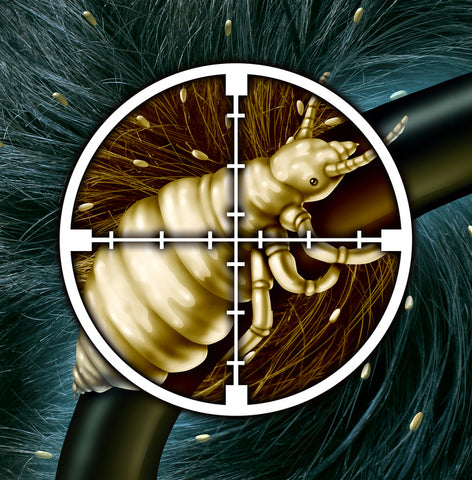Stay LICE FREE this Back-to-School Season!
Back to school time is here, and for many parents that means a return to the reality of dealing with lice! There are many ways to attempt to prevent lice, yet educating yourself and your children is crucial.
If your child does bring home lice, try not to panic! Lice don’t spread any diseases and they do not indicate that your child or home is dirty. In reality, lice prefer squeaky clean hair to grip on to!
First, the facts. Head lice don’t jump, they only crawl, which is why they are so prevalent in young daycare and school-aged children (most commonly from ages 3 to 11) who spend long periods of time in close quarters. Even adult lice are miniscule; they are only about 2 to 3 millimeters in length. Lice feed off the blood of the scalp and lay their eggs on the hair shaft close to the scalp. The itchiness commonly associated with a case of head lice is from an allergic reaction to the bites of the louse. Some children may also report that they feel something crawling in their hair or have trouble sleeping at night as lice are more active when it is dark. A lice egg is called a nit; they are extremely small and appear white or pale yellow and are very hard to see. After the eggs are laid, they grow for about 8 to 9 days before hatching. As they grow, they become easier to see, which is why you need to continue to check daily for the louse’s full lifecycle. The key to successfully eradicating lice is to interrupt the lifecycle of the louse, or said differently, you want to remove all of the adults so they can’t lay anymore eggs. An immature louse is called a nymph, and nymphs take 9 to 12 days to reach maturity where they can begin to lay their own eggs. This is why you will still need to check the hair daily for 14 days to make sure you have removed ALL the eggs and nits.
You should also be aware of the lice and nit policy at your school. Some schools send children home and will not let them come back to school until they are completely lice and egg free. This is commonly called a “no-nit policy.” It’s a struggle for parents and children to miss school and work to handle a case of lice. But some districts are moving in a different direction. In an article in Slate Magazine, Dan Kois discusses his children’s school’s new lice policy:
“If a child has lice in her hair, the nurse will contact parents but send the child back to the classroom for the rest of the day. Parents are expected to treat the lice, but no one is checking in to enforce this expectation. No classes or groups will be screened for bugs. “No healthy child,” the policy reads, “should be excluded from or miss school because of head lice… Arlington’s new stance on lice is being adopted by schools all over the country, encouraged by the American Academy of Pediatrics and the National Association of School Nurses. And it’s the right one. Lice are not particularly contagious, they hurt basically no one, and they’re not a public health risk. Lice don’t actually matter. It’s high time that squeamish parents and school administrators stop acting like they do.”
It’s an interesting and progressive policy but unlikely to be widely adopted anytime soon. For now, as parents hear the word “lice.” it requires an immediate call to action. Until lice policies change nationwide, here are some ideas to prevent lice in the school or daycare setting, and keep your children engaged and learning at school!
Keep long hair pulled back in a ponytail, braid or bun. There are lots of fun styles and accessories to try so that kids don’t have to sacrifice style for freedom from lice. Of course, kids should not share the cute headbands, clips and scrunchies as lice can hitch a ride on these kinds of accessories and survive for up to two days without a human host.
Along the same lines, you should tell your kids not to share scarves and hats! With winter approaching, hats and scarves are set to escape their bins, and while it may seem like common sense not to share hats, scarves can be just as complicit when it comes to spreading lice. Remind kids that lice like the warm areas behind the ears and at the nape of the neck - exactly where their scarves rest!
If your children are involved in theater (think wigs, hats, costumes being swapped around the cast) or sports (with helmets, jerseys, towels shared amongst the team) consider investing in your child’s own equipment or give your child a quick spray with a lice repellent before heading out the door!
Want a NON-TOXIC and proven way to protect against lice at school?
Buy the RobiComb® Today and Kill the Lice on Contact!
No Chemicals. Safe for Kids.
Buy Today at Your Local Pharmacy
- LiceGuard Webmaster













Comments 0